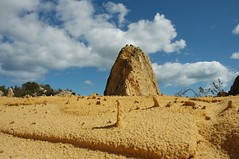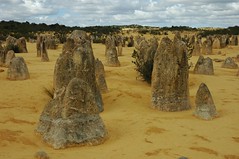See my Flicker photo set of the pinnacles here.
Nambung National Park, on the Swan Coastal Plain 245km north of Perth, contains on of Australia's most fascinating landscapes – the Pinnacles Desert.
Out of the shifting yellow sands rise thousands of huge limestone pillars, standing in stark contrast to the surrounding low heathlands typical of this coast.
The pinnacles often feature in tourist guides to the region, but they are only one part of the 17491 ha National Park. Beautiful beaches, coastal dune systems and trees and flowering plants typical of the northern coastal plain are all part of this park.
Summer days between December and March are usually hot and dry, with an afternoon sea breeze. During this time the fire danger is often extreme. Wildlife rests during the heat of the day, and only appears in the cooler hours of early morning and evening.
Most of the annual 600mm of rain falls between May and September. From September onwards the weather warms up, but the days are still mild and native wildflowers throughout the area start their spring bloom. This is the best time of year to discover the pinnacles and explore the park.
The Environment
Three old systems of sand dunes run parallel to the WA coast from Nambung to Busselton. These dunes, formed from wind-blown beach sand rich in ime, mark acient shorelines on the Swan coastal plain.
The dune systems become older and more gentle and undulating the further they are from the sea. The shape and character of the sands determine the plants that will grow on them.
The Quindalup system of white, lime-rich sands is found immediately inland from the foredunes and is constantly being added to by sand from the foredunes and the beach.
The vegetation here is strongly influenced by the shape of the dunes. Acacia thickets are common in the small valleys between the dunes and on the leeward slopes.
Further inland the older Spearwood dunes occur. These are yellow and brownish quartz sands, and often overlie limestone. The pinnacles are the eroded remnants of what was once a thick bed of limestone beneath these sands.
Tuart woodlands occur in the valleys, but it is the low exposed heaths of acacia and myrtles extending inland to the Pinnacles Desert which dominate the landscape. Scattered over these low heaths grow casurinas and banksias. The brilliant orange flowered Banksia prionotes is common.
The silica-rich sands of the Bassendean system are found on the east of the Park where the vegetation is low, open banksia woodland.
Most animals in the Park are nocturnal, but during the day you may see emus or western grey kangaroos. Reptiles of many sorts are common, particularly bobtail skinks and snakes. Over 90 species of birds common to the Swan Coastal Plain have been recorded in the Park.
The most popular attraction of the Park is the Pinnacles Desert. Thousands of limestone pillars, up to four meters tall, rise out of a stark landscape of yellow sand. Some are jagged, sharp-edged columns, rising to a point; others resemble tomb-stones. What exactly are the pinnacles? What natural processes have created these odd and spectacular structures?
The Raw material for the limestone of the pinnacles came from sea shells in an earlier epoch rich in marine life. These shells were broken down into lime-rich sands which were carried inland by wind to form high, mobile dunes.
Winter rain leached the lime from these sands, cementing grains of sand together in the lower levels of the dunes. Vegetation became established and stabilized the dunes. At the same time, an acidic layer of soil and humus developed over the remaining quartz sand.
This acidic soil accelerated the leaching process, and a hard layer of calcrete formed over the softer limestone below. Today this calcrete can be seen as a distinct cap on many pinnacles and has helped protect the softer limestone below.
Cracks formed in the calcrete layer and were exploited by plant roots. Water seeped down along these channels to leach away the softer limestone beneath. The channels gradually filled with quartz sand. This subsurface erosion continued until only the most resilient columns remained. The pinnacles as we see them today were exposed by prevailing winds blowing away the overlying quartz sand.
-Gary Milner





No comments:
Post a Comment